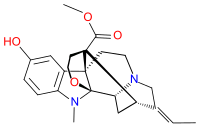Akuammine

| |
| Names | |
|---|---|
| Other names
Vincamajoridine
| |
| Identifiers | |
3D model (
JSmol ) |
|
| ChEMBL | |
| ChemSpider | |
PubChem CID
|
|
| UNII | |
| |
| |
| Properties | |
| C22H26N2O4 | |
| Molar mass | 382.460 g·mol−1 |
| Melting point | 225 °C (437 °F; 498 K)[1] |
Except where otherwise noted, data are given for materials in their standard state (at 25 °C [77 °F], 100 kPa).
| |
Akuammine (vincamajoridinePicralima nitida,[3] commonly known as akuamma, comprising 0.56% of the dried powder. It has also been isolated from Vinca major.[2] Akuammine is structurally related to yohimbine, mitragynine and more distantly Voacangine, all of which are alkaloid plant products with pharmacological properties.
Pharmacology
Akuammine has
antimalarial activity,[3] and may be the primary constituent of P. nitida seeds responsible for this activity.[4]
Akuammine is an
References
- ^ Merck Index (12th ed.). 200.
- ^ PMID 13262018.
- ^ S2CID 260253044.
- ISBN 9783826100772.
- PMID 9683021.
- PMID 1317407.
